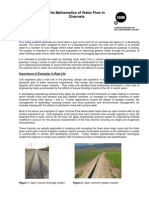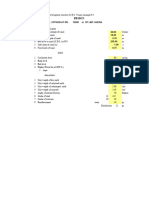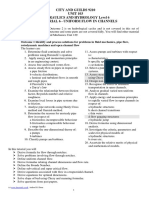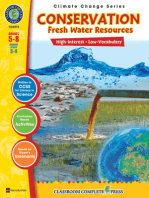0 ratings0% found this document useful (0 votes)
37 viewsReport Math
The document outlines a FILA table for a project on calculating water volume and rate of change in an open channel trough. The table includes facts about the trough dimensions, ideas such as the flow being uniform, learning objectives like calculating volume and rate of change, action plans to research the topics and discuss with others, and a conclusion stating understanding was gained of derivatives and how to set up rate of change equations.
Uploaded by
ummi surayaCopyright
© © All Rights Reserved
Available Formats
Download as DOCX, PDF, TXT or read online on Scribd
0 ratings0% found this document useful (0 votes)
37 viewsReport Math
The document outlines a FILA table for a project on calculating water volume and rate of change in an open channel trough. The table includes facts about the trough dimensions, ideas such as the flow being uniform, learning objectives like calculating volume and rate of change, action plans to research the topics and discuss with others, and a conclusion stating understanding was gained of derivatives and how to set up rate of change equations.
Uploaded by
ummi surayaCopyright
© © All Rights Reserved
Available Formats
Download as DOCX, PDF, TXT or read online on Scribd
You are on page 1/ 2
FILA TABLE
FACTS
IDEAS
LEARNING
ISSUES
ACTION PLANS
1. The depth of
the trough is 8
meter
1. The depth of
through is too
deep
1. Find the volume
of water
1. Find information
through books,
websites
2. The width is 5
meter
2. It is uniform
flow
2. Differentiate
the volume
2. Calculate the
rate of change
3. The height is
2 meter
3. Water flows in
open channel
3. Find rate
change of the
height
3. Sharing ideas
with members
4. The shape of
the through is
isosceles
4. The channel is
in regular channel
4. Discuss with
lecturer
CONCLUSION
In conclusion, through the completion of this project, we gained a firm
understanding of derivatives. We know how to set up and solve rate of change
equations using derivatives. Our reflections will be a basis for our preparation
and studies for the day in which we will take our own Civil Engineering
Mathematics 1 examination. Writing reflections is a skill that should be continued
beyond this lesson.
REFERENCE
1. www.questgarden.com
You might also like
- Elementary Science Experiments: Analyzing Data to Make PredictionsFrom EverandElementary Science Experiments: Analyzing Data to Make PredictionsNo ratings yet
- Differentiated Lessons for Every Learner: Standards-Based Activities and Extensions for Middle SchoolFrom EverandDifferentiated Lessons for Every Learner: Standards-Based Activities and Extensions for Middle School3.5/5 (16)
- Refa Alana Syalwa Saputra Survey of existing drainage channelNo ratings yetRefa Alana Syalwa Saputra Survey of existing drainage channel5 pages
- The Mathematics of Water Flow in Channels: ScenarioNo ratings yetThe Mathematics of Water Flow in Channels: Scenario5 pages
- Ocean's World Educator's Guide: An Island Tale of Discovery and AdventureFrom EverandOcean's World Educator's Guide: An Island Tale of Discovery and Adventure5/5 (2)
- Candidates Are Required To Give Their Answers in Their Own Words As Far As Practicable. The Figures in The Margin Indicate Full MarksNo ratings yetCandidates Are Required To Give Their Answers in Their Own Words As Far As Practicable. The Figures in The Margin Indicate Full Marks2 pages
- City and Guilds 9210 UNIT 103 Hydraulics and Hydrology Level 6 Tutorial 6 - Uniform Flow in ChannelsNo ratings yetCity and Guilds 9210 UNIT 103 Hydraulics and Hydrology Level 6 Tutorial 6 - Uniform Flow in Channels20 pages
- Five D’s of Instructional Design: Empowering Student-Centered Learning Excellence: Unveiling the 5 D's Framework for TransformationFrom EverandFive D’s of Instructional Design: Empowering Student-Centered Learning Excellence: Unveiling the 5 D's Framework for TransformationNo ratings yet
- Task: 1 Discharge Measurement Using Floating MethodNo ratings yetTask: 1 Discharge Measurement Using Floating Method3 pages
- 1154 CE F213 20230107111035 Comprehensive Exam Question PaperNo ratings yet1154 CE F213 20230107111035 Comprehensive Exam Question Paper2 pages
- Department of Technical Education Andhra PradeshNo ratings yetDepartment of Technical Education Andhra Pradesh11 pages
- Differential Calculus Application ProblemsNo ratings yetDifferential Calculus Application Problems23 pages
- Hydrology - Tutorial 1 Uniform Flow in Channels: WWW - Freestudy.co - UkNo ratings yetHydrology - Tutorial 1 Uniform Flow in Channels: WWW - Freestudy.co - Uk0 pages
- Gujarat Technological University: InstructionsNo ratings yetGujarat Technological University: Instructions2 pages


































































